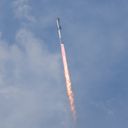SpaceX's Starship reaches space and reenters atmosphere for 1st time in ambitious test

SpaceX's massive Starship on Thursday successfully went to space and reentered Earth's atmosphere for the first time during its third and most ambitious test flight thus far.
Why it matters: The test was a major leap for the vehicle, which is essential for NASA's Artemis program. The flight featured technologies critical for any future manned missions to the moon or beyond.
What they did: The spacecraft, the largest ever built, launched from the company's Starbase in Boca Chica, Texas, around 9:25am ET.
- After liftoff, it successfully separated from its huge booster, which went on to perform a controlled descent flight back to Earth before crashing in the Gulf of Mexico.
- Meanwhile, the spacecraft carried on to perform several tests while in orbit. It opened its payload door and transferred tons of liquid oxygen between two tanks to simulate an in-orbit refueling of the ship.
- After the tests, Starship started a controlled reentry and reentered Earth's atmosphere before SpaceX lost contact with the ship. It was expected to perform a soft landing in the Indian Ocean.
- SpaceX said the ship did not survive reentry.
Starship re-entering Earth's atmosphere. Views through the plasma pic.twitter.com/HEQX4eEHWH
— SpaceX (@SpaceX) March 14, 2024
Zoom in: The failed landing will likely trigger a mishap investigation from the Federal Aviation Administration.
- Such probes are routine after tests don't go according to plan.
- Still, it was a major improvement from previous tests.
- The company likely gathered a lot of data throughout it, which may lead to improvements to the vehicle's design.
Context: The Starship's second test flight last year ended abruptly without meeting the stated goals for the test.
- The vehicle's huge lower-stage booster exploded after a successful separation from the upper-stage spacecraft portion. The upper stage then exploded after reaching an altitude of about 90 miles.
- The first test flight earlier in 2023 ended with another explosion, though that was after the rocket punched a crater through the launchpad and spread debris for miles around the launch site.
Yes, but: Such spectacular blunders have been a part of the company's hardware engineering philosophy: move fast, embrace failures and learn from them.
- The philosophy and its safety considerations have been criticized as cavalier for human spaceflight.
- Still, SpaceX has rapidly become the most prolific human spaceflight provider so far without a catastrophic failure.
What they're saying: "Each of these flight tests continue to be just that: a test," the company said before launch.
- "They aren't occurring in a lab or on a test stand, but are putting flight hardware in a flight environment to maximize learning."
The big picture: NASA has selected the company to carry astronauts to the surface of the moon as early as 2026 on a lander variant of Starship.
- If the company has its way, Starship will one day fly people and cargo even deeper into space to destinations like Mars.
- SpaceX hopes Starship will one day be fully reusable like its Falcon 9 rocket.
Go deeper: Democrats launch SpaceX probe over Russian use of Starlink satellites
Editor's note: This story was updated with the latest developments in the launch.